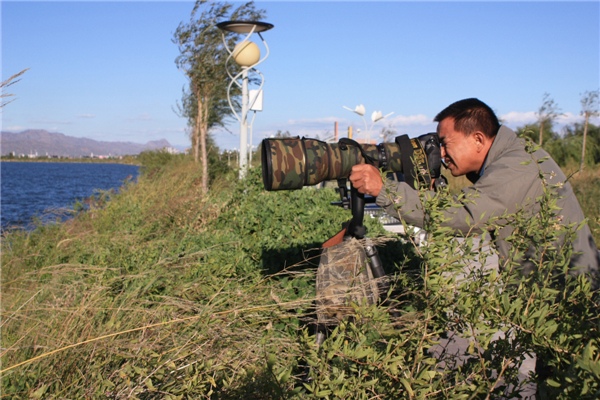Wetlands a world for birds
Updated: 2013-05-07 08:10
By Wang Kaihao (China Daily)
|
||||||||
 |
|
Chen Xuegu, a photographer at Nanhai reserve snaps flocks of migratory birds at the wetland. Provided to China Daily |
Protectors work hard to save their fluffy friends, reports Wang Kaihao in Baotou, Inner Mongolia autonomous region.
For Chen Xuegu, 51, the Nanhai wetland is almost his entire world.
Since the first whooper swan landed on the waters alongside the Yellow River in late January, Chen has been working hard. Every morning, he rises before daybreak to take photos of flocks of migratory birds.
"My mother often calls and tells me to keep away from the birds," he smiled. "She's scared of the H7N9 flu. Well, it's our honor to have these flying guests coming up from the south. I have no reason to keep away from them."
Nevertheless, he recently bought a new pair of rubber boots in case he inadvertently steps in bird droppings. As the only full-time photographer at the Nanhai Wetland Reserve, covering almost 1,600 hectares in Baotou, the Inner Mongolia autonomous region, he also monitors the condition of the local fauna and looks for dead birds.
Apart from two years in the People's Liberation Army, Chen has spent his life around the wetlands and calls himself a Wetlander. Born into a fishing family, he grew up watching all kinds of waterfowl. As a child, he often joined friends to trap birds for food, and, he admits, for fun, but he is pleased times have changed.
Nanhai is an important link in a wetland chain along the Yellow River, a crucial route for various species of migratory birds heading to Siberia from China's southernmost provinces.
The reserve has a patrol team of eight at its wetland protection station. According to the head, Miao Chunlin, the frequency of daily patrols has recently risen. Miao's squad undertakes two-hour patrols at least twice a day. The frequency is increased whenever the schedule allows.
Observation towers provide an overview of the area. The station began daily patrols in 2007, and keeps a detailed record. Despite the recent outbreak of bird flu, no unusual deaths have been discovered.
The National Forestry Bureau released an urgent statement in early April, ordering nature reserves at all levels to intensify the supervision of migratory birds to allay a possible spread of H7N9. However, although bird droppings are suspected to contain the virus, so far, tests have not provided any concrete evidence.
In mid-April, the National Forestry Bureau sent a team to Ulansuhai Nur, in Bayannur city, also along the Yellow River, to collect 120 samples of Mute Swan droppings to see if any contained the virus. No positive results have yet been reported.
However, despite being situated closer to Baotou's densely populated areas, Nanhai was unable to take equally stringent action. According to Bao Jiaoqi, the director of the wetland protection center at Baotou's municipal forestry bureau, any wild birds that die of disease are immediately sent for examination, but the measure is not a response to H7N9.
Baotou has not tested bird droppings because the tests can only be conducted at national-level laboratories, which are currently focusing more on China's national-level natural reserves, according to Bao.
"There is no confirmed link between wild migratory birds and H7N9, based on our observations," said Yang Guisheng, professor of ornithology at the Inner Mongolia University. "However, further studies are ongoing, but we can't really check to see if all migratory birds are safe because their numbers are huge."
For now, Nanhai's patrol teams can only warn tourists and local residents to keep away from the birds. Miao said the staff remain optimistic in the face of H7N9, especially after the area was the scene of a crisis almost a decade ago.

 Michelle lays roses at site along Berlin Wall
Michelle lays roses at site along Berlin Wall
 Historic space lecture in Tiangong-1 commences
Historic space lecture in Tiangong-1 commences
 'Sopranos' Star James Gandolfini dead at 51
'Sopranos' Star James Gandolfini dead at 51
 UN: Number of refugees hits 18-year high
UN: Number of refugees hits 18-year high
 Slide: Jet exercises from aircraft carrier
Slide: Jet exercises from aircraft carrier
 Talks establish fishery hotline
Talks establish fishery hotline
 Foreign buyers eye Chinese drones
Foreign buyers eye Chinese drones
 UN chief hails China's peacekeepers
UN chief hails China's peacekeepers
Most Viewed
Editor's Picks

|

|

|

|

|

|
Today's Top News
Shenzhou X astronaut gives lecture today
US told to reassess duties on Chinese paper
Chinese seek greater share of satellite market
Russia rejects Obama's nuke cut proposal
US immigration bill sees Senate breakthrough
Brazilian cities revoke fare hikes
Moody's warns on China's local govt debt
Air quality in major cities drops in May
US Weekly

|

|







